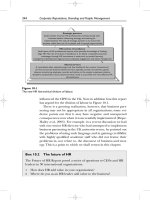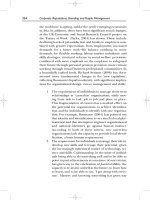Branding unbound
Bạn đang xem bản rút gọn của tài liệu. Xem và tải ngay bản đầy đủ của tài liệu tại đây (1.9 MB, 252 trang )
BRANDING
UNBOUND
THE FUTURE OF ADVERTISING, SALES,
AND THE BRAND EXPERIENCE IN THE WIRELESS AGE
R I C K M AT H I E S O N
A M E R I C A N M A N A G E M E N T A S S O C I AT I O N
New York • Atlanta • Brussels • Chicago • Mexico City • San Francisco
Shanghai • Tokyo • Toronto • Washington, D.C.
................. 11341$
$$FM
05-24-05 10:44:39
PS
PAGE i
Special discounts on bulk quantities of AMACOM books are
available to corporations, professional associations, and other
organizations. For details, contact Special Sales Department,
AMACOM, a division of American Management Association,
1601 Broadway, New York, NY 10019.
Tel.: 212-903-8316. Fax: 212-903-8083.
Web site: www.amacombooks.org
This publication is designed to provide accurate and authoritative
information in regard to the subject matter covered. It is sold with the
understanding that the publisher is not engaged in rendering legal,
accounting, or other professional service. If legal advice or other expert
assistance is required, the services of a competent professional person
should be sought.
Library of Congress Cataloging-in-Publication Data
Mathieson, Rick.
Branding unbound : the future of advertising, sales, and the brand experience in the
wireless age / Rick Mathieson.— 1st ed.
p. cm.
Includes bibliographical references and index.
ISBN 0-8144-7287-7
1. Mobile commerce. 2. Product management. I. Title.
HF5548.34.M38
658.8Ј72—dc22
2005
2005002544
᭧ 2005 Rick Mathieson.
All rights reserved.
Printed in the United States of America.
This publication may not be reproduced,
stored in a retrieval system,
or transmitted in whole or in part,
in any form or by any means, electronic,
mechanical, photocopying, recording, or otherwise,
without the prior written permission of AMACOM,
a division of American Management Association,
1601 Broadway, New York, NY 10019.
Printing number
10 9 8 7 6 5 4 3 2 1
................. 11341$
$$FM
05-24-05 10:44:39
PS
PAGE ii
FOR JUDY AND KATE,
MY REASONS
................. 11341$
$$FM
05-24-05 10:44:39
PS
PAGE iii
This page intentionally left blank
................. 11341$
$$FM
05-24-05 10:44:39
PS
PAGE iv
Contents
Introduction
1
Marketing’s Wireless Future Is Here. Ready to Make
the Most of It?
From Here to Ubiquity
The Burger King Syndrome
Winning Without Wires
Talking ’bout a Revolution
1
3
5
9
11
C H A P T E R ON E
The Rise of mBranding
15
A Boom with a View
Mobile Marvels
mBranding: A Definition
Immediacy
Intimacy
Interactivity
Mobility
Immersion
Getting There
................. 11341$
17
20
22
23
25
28
30
32
33
CNTS
05-24-05 10:44:44
PS
PAGE v
vi
Contents
Q&A
Don Peppers: 1:1 Marketing Goes Wireless
35
CHAPTER TWO
Reach Out & Sell Someone:
The Top 10 Secrets of Successful Mobile Advertising
‘‘Treading Lightly’’
࠻1: Size Matters
࠻2: No Pushing Allowed
࠻3: Integration Is the Name of the Game
࠻4: Entertainment Rocks
࠻5: Sponsorships Rule
࠻6: It’s Time to Get Personal
࠻7: Location Is (Sometimes) Where It’s At
࠻8: The Medium Is (Still) the Message
࠻9: Think Young—to a Point
࠻10: There’s No Time Like Now
41
42
43
48
52
55
59
61
62
64
65
67
Q&A
Christopher Locke:
‘‘Cluetrain Manifesto’’ for the Mobile Age
69
CHAPTER THREE
Dialing for Dollars: M-Commerce Puts Sales in Motion
Hollywood @ Hand
E-Commerce, Unleashed
No Wires, No Waiting
The Perfect Storm
That’s the Ticket
Vox Humongous
Puttin’ on the Hits
Personal Calls
Games People Play
................. 11341$
79
80
83
85
88
89
91
94
95
97
CNTS
05-24-05 10:44:44
PS
PAGE vi
vii
99
102
Contents
Get Your Game On
Star Attractions
Q&A
Gary Hamel: Leading the (Wireless) Revolution
103
CHAPTER F OUR
A Moving Experience:
The New World of Place-Based Marketing
Serving Ads in a New York Minute
Welcome to the Great Outdoors
Nielsen to Go
Sudden Impact
The Fast and the Curious
Not Your Father’s Oldsmobile
Drivers Wanted
Ready to Roll?
109
112
113
116
117
118
119
122
124
Q&A
Chet Huber: Driving Ambition
127
CHAPTER F IVE
The Wireless Point of Persuasion:
Shopping for Insights at the Store of the Future
Radar Love
Food on the McFasTrak
Lost in Space
Worth Your Aisle
You Won’t Believe Your Ears
From Prada, with Love
Tag, You’re It
Smart Shelves, Dumb Problems
................. 11341$
133
136
137
139
140
142
145
147
148
CNTS
05-24-05 10:44:44
PS
PAGE vii
viii
Contents
Q&A
Seth Godin: Permission Marketing and
‘‘My Own Private Idaho’’
151
CHAPTER S IX
Service with a Stylus:
Creating the Ultimate Guest Experience
Restaurants: The (Wireless) Hand that Feeds You
Hotels: Where Wireless Is Inn Vogue
Theme Parks: Mickey Goes Mobile
Planes, Trains, and Automobiles: Hassle-Free Travel
Takes Off
155
156
158
163
165
Q&A
Tom Peters: The Gospel According to St. Peters
169
CHAPTER SEVEN
No Wires, New Rules: The Wireless World’s New
Social Fabric—And What It Means to Marketers
Social Networking: Moving to the Groove
Mobility םBlogging סMoblogging
High-Tech Hijinks
The Wireless Underground
173
175
179
185
188
Q&A
Howard Rheingold:
The Mobile Net’s New ‘‘Mob’’ Mentality
191
CHAPTER EIGHT
Marketing 2020:
The Future According to Spielberg
Report from Tomorrow
News Flash
................. 11341$
197
198
200
CNTS
05-24-05 10:44:45
PS
PAGE viii
ix
202
203
207
211
211
Notes
213
A Glossary of mBranding: A Quick Reference Guide
229
Acknowledgments
235
Index
239
About the Author
245
................. 11341$
CNTS
05-24-05 10:44:45
PS
Contents
A World (Wide Web) at Your Fingertips
Life as a Pop-Up Ad
Marketing Nirvana, or Privacy Nightmare?
Future Shock
The Power Belongs to You
PAGE ix
This page intentionally left blank
................. 11341$
CNTS
05-24-05 10:44:45
PS
PAGE x
Introduction
Advertising displays that call out to you on a first-name basis.
Services that let you shop for pizza, music, books, and movies—anywhere,
anytime.
Stores where the costs of goods is automatically deducted from your bank
account—without you ever writing a check, doling out cash, swiping a
card, or standing in line.
And commercials broadcast so only you can hear them—seemingly from
inside your own head.
MARKETING’S WIRELESS FUTURE IS HERE.
READY TO MAKE THE MOST OF IT?
It turns out that the Internet was just a warm-up act. A decade
ago, the Internet hype machine pitched the World Wide Web as
a marketer’s dream come true—an interactive, one-to-one utopia,
................. 11341$
INTR
05-24-05 10:44:49
PS
PAGE 1
2
Branding Unbound
linking shoppers and their quarry in the electronically enabled Elysium Fields of 24-7 commerce.
Of course, Google, Amazon, and eBay notwithstanding, banner
ads, online ‘‘communities of interest,’’ and click-and-mortar ‘‘e-tailing’’ have yet to truly deliver the eyeballs, interest, or sales they
promised—tethered as they’ve been to a cumbersome, confounding
device called the desktop PC.
Now, all that’s changing. A new generation of wireless Internet
technology is finally liberating the Net from its deskbound subjugation. Thanks to new wireless devices and high-speed mobile
networks, the Information Superhighway and its advertising ‘‘billboards,’’ applications, and services are finally hitting the road with
you. Along the way, they’re delivering on two tenets, heretofore
unfulfilled, that are central to the Internet’s promise. The first: anywhere. The second: anytime.
Today, there are over 1.7 billion Internet-enabled cell phones
worldwide, allowing users to browse the Web, take pictures, send
e-mail, watch TV, play games, and yes, even talk.1 By 2007, there
will be a billion more—one for every three people on the planet—
each sporting computing power that rivals that of NASA’s original
Apollo space program.2, 3 Meanwhile, nearly 600 million wirelessenabled laptop computers, PDAs, and ‘‘smart phones’’ (cell phone/
PDA hybrids) feature new forms of wireless connectivity—‘‘wireless fidelity’’ (Wi-Fi), ultra-wideband, Bluetooth, and ‘‘third generation’’ (3G) cellular, among others—many only now becoming
familiar to the average consumer.4 Factor in emerging new fuel-cell
batteries that will untether devices for longer and longer periods of
time and, say experts, these whole new levels of connectivity and
computing power will fundamentally redefine how—and where—
people live, work, learn, and play.
‘‘This confluence of technologies is really unprecedented in the
short history of electronic technology,’’ says Gene Becker, program
director for the Mobile and Media Systems Lab at Hewlett-Packard.
‘‘The end result is a lot of opportunity for innovation and experimentation in the ways that people use this stuff. Clearly the mobile
................. 11341$
INTR
05-24-05 10:44:49
PS
PAGE 2
3
Introduction
experience is going to be one of them that is transformed quite
extraordinarily.’’*
In fact, it has already begun.
FROM HERE TO UBIQUITY
To most marketers outside Japan, the word DoCoMo may still
evoke the name of a particularly unfortunate Beach Boys song. But
to the world’s high-tech digirati, the name of Japan’s dominant mobile services carrier has long been synonymous for high-speed, highbandwidth, high-octane wireless innovation.
Train-bound Japanese commuters watch TV, play games, and
shop from their 3G-enabled NTT DoCoMo i-mode handsets. Keiti
(handset)–crazed teenagers videoconference with their far-flung tomodachi. And a society short on landline Internet connections, and
shorter on personal living space, has embraced the Internet—many
without ever logging on to a PC.
Seven hundred fifteen miles to the northeast, wireless is the
rage for 34 million South Koreans who use their cell phones to do
everything from making purchases, to trading securities, to checking closed-circuit traffic cameras before making the trip home. In
2004, 500 Korean families moved into homes wired with Samsung’s
‘‘hometiva’’ technology.5 Using a tablet-like ‘‘Home Pad’’ or a cell
phone, they can call up a movie to their plasma screen TVs, brew
coffee, or even tap into surveillance cameras to monitor for prowlers. By 2007, Korea’s Ministry of Information and Communications
hopes to expand this level of connectivity to over 10 million households.6
Meanwhile, from Manila to Helsinki to London, teenagers use
cell phones, pagers, and PDAs to send text messages, also called
SMS for ‘‘short message services,’’ to coordinate protests, to stage
*Note: Quotations without sources come from interviews conducted specifically for
Branding Unbound; those with sources are from the author’s previously published work
or from the sources specified.
................. 11341$
INTR
05-24-05 10:44:49
PS
PAGE 3
4
Branding Unbound
raves, or simply to connect with friends in what techno-anthropologist Howard Rheingold famously described as ‘‘Thumb Tribes.’’
The craze even has its first malady—a condition called ‘‘Texter’s
Thumb,’’ a form of tenosynovitis that causes inflammation of the
tendons that snake along the hand and wrist due to pecking out
excessive numbers of messages.7
In 2006, consumers will send an estimated 700 billion text messages worldwide, according to industry trade group GSM Association. And as mobile IM, or Instant Messaging via cell phones,
proliferates, the number of messages could prove quite staggering.
These same sorts of technologies are taking off in the United
States.
Over 40 million Americans actively use text messaging, including 57 percent of all eighteen- to twenty-five-year-old mobile subscribers, according to mobile marketing firm Enpocket.8 Over 13.5
million people regularly send text messages to vote for contestants
on Fox-TV’s American Idol talent show.9 And American cell phone
subscribers are spending nearly $250 million to download the latest
hit music-clip ‘‘ringtone.’’10
But this digital revolution is much, much more than just Internet-enabled handsets, music downloads, and SMS–wielding adolescents. Increasingly, it’s about everyday products being embedded
with ubiquitous, ‘‘always-on’’ wireless connectivity and intelligence.
The OnStar service in your car, for instance, uses global positioning system (GPS) technologies to pinpoint your location with
an accuracy of within ten meters, gives you verbal directions to
your next destination, unlocks your door if your toddler locks himself in with the keys, and calls 911 if your airbags are deployed in a
crash. Similar GPS technologies in ‘‘Personal Locator Devices,’’ like
those from Wherify, can help you monitor your child’s every move
from a secure Web site, and alert you if Johnny doesn’t make his 3
p.m. piano lesson or if Sally ventures too far from the neighborhood.
The Bluetooth connection in your digital camera transmits the pictures from Mom’s birthday party to the nearest desktop printer.
The Wi-Fi–based Apple Airport Express hub connected to your
home computer broadcasts your collection of Maroon 5 MP3s from
any stereo system in the house. And the radio frequency identifica-
................. 11341$
INTR
05-24-05 10:44:49
PS
PAGE 4
5
Introduction
tion (RFID)–based transponder affixed to your car electronically
pays for toll roads and bridges without you ever having to let up
on the accelerator.
As 3G cellular networks begin to proliferate here, they will enable unified voice, video, and data connections that let you use your
mobile phone to videoconference your kids and see how they’re
doing—quite literally. Soon, ‘‘smart clothes’’ will routinely monitor
heart patients and alert doctors to impending heart attacks.11 Tiny
‘‘smart dust’’ sensors, less than one hundred cubic millimeters in
size, will monitor the nation’s food supply for chemical and biological agents—and provide video, audio, and troop movement analysis
on the battlefield. And projects like Korea’s Smart Home initiative
presage an age of intelligent homes, buildings, and stores that react
to your every command, or offer you up services and goods based
on your personal preferences.12
Yet for all the frissons these possibilities may inspire, the second
chapter of the Internet is quite different from the first. Hobbled by
the dot-com implosion and hyperlink-inspired hyperbole, the Internet’s emerging wireless era is predicated on using practical, inexpensive technology to simply extend proven business solutions
from the virtual world into the real one.
And while wireless has many applications, from health care, to
defense, to supply chain management, to education, the impact
may be most profound and promising—and perilous—for those at
the front lines of twenty-first-century business: marketers.
THE BURGER KING SYNDROME
Already, the convergence of high-speed networks and new digital
devices is dramatically reshaping the cultural and media landscapes.
A generation weaned on TiVo, video on demand (VOD), chat
rooms, and instant messaging has grown accustomed to living
seamlessly and simultaneously on- and offline. American teens and
twenty-somethings are gravitating to new ‘‘social networking’’ services like Dodgeball, which lets them send text messages to alert
................. 11341$
INTR
05-24-05 10:44:50
PS
PAGE 5
6
Branding Unbound
friends of their current whereabouts so they can meet up, make
plans, or just get their gossip on.
Managers surf the Web while trapped in interminable meetings.
Moms call home while standing in line for groceries. We’ve all
grown accustomed to time-shifting our consumption of media—
watching our favorite TV shows when we get a spare moment,
instead of the second they’re broadcast. And we’re increasingly
skipping the advertising all together.
Part of this change is the direct result of the sheer multitude of
entertainment choices afforded by digital technology. Thirty-seven
percent of Americans say they watch less television due to online
activities, according to a report on broadband Internet usage by the
Pew Internet and American Life Project.13
‘‘Twelve years ago, you could reach 50 percent of the American
audience with three TV spots, and today, it takes seventy,’’ says
Chuck Porter, a founder of Miami-based advertising powerhouse
Crispin Porter םBogusky (CPB). ‘‘Media fragmentation has absolutely forced advertisers to rethink the way to build brands.’’
Indeed, according to one controversial report from Nielsen
Media Research, there are indications that up to 13 percent of one
of America’s most important cohorts, the young male audience, has
abandoned network television in recent years—lost, presumably, to
cable, the Internet, and video games.14
Ah, those video games: By some estimates, they now score over
$11 billion a year. That’s more than Hollywood makes at the U.S.
box office.15 Since 1997, the compound annual growth rate in the
number of consumers playing video games has topped 14 percent,
while watching television and cable has grown only 1.9 percent.16
As you might imagine, the entire gaming segment is heading into
hyperdrive as games go mobile—a burgeoning segment that will
top $1 billion in the United States by 2008, according to IDC analyst
Lewis Ward.
And it’s not just first-person shooter games for young male
punks. In the United States, women 18 and older now make up 40
percent of all Internet gamers, and 58 percent of all mobile gamers.17, 18 Women of all ages are turning to the Internet, both wireline
................. 11341$
INTR
05-24-05 10:44:50
PS
PAGE 6
7
................. 11341$
INTR
05-24-05 10:44:50
PS
Introduction
and wireless—accounting for 60 percent of all online purchases, according to Nielsen/NetRatings.
Meanwhile, 69 percent of consumers express interest in ad-skipping technologies like TiVo and other digital video recorders
(DVRs).19 Nearly 33.5 million households will adopt the technology
by the end of 2008—up dramatically from 7 million homes in early
2005, according to research firm Yankee Group.20 And new handheld versions, like Microsoft’s Media2Go and movies-music-gaming
‘‘media center’’ versions of the Sony PSP and the VIA Eve console,
are increasingly popular.
Combine this trend with new satellite-based broadband TV/
Internet/phone networks like those from Clearwire and WildBlue,
and peer-to-peer networks like Kazaa, Grokster, and eDonkey, and
suddenly, content of all kinds—digital TV, movies, music, games,
photos, personal information, shopping, and more—takes on a level
of portability, accessibility, and personalization previously unimaginable.
Armed and wireless, the most unsatisfied members of our consumer republic will increasingly reject media that fail to meet their
interests and increasingly mobile, interconnected lifestyles. Others
will enhance their television, radio, and print experiences with the
kind of instant, personalized interactivity no other medium can provide.
Like the Burger King commercials of yore, the only rule that
matters in this increasingly fragmented mediascape is as simple as
it is powerful: Now more than ever, it’s your way, or no way at all.
For Madison Avenue, this means change is, quite literally, in
the air.
‘‘The creative community is still fixated with thirty-second
commercials, and the clock is ticking,’’ Coca-Cola president Chuck
Fruit recently declared, adding that brands like Coke spend roughly
three-fourths of their ad budgets on television. ‘‘That percentage
will go down steadily for the next decade to well under half.’’21
At issue: accountability. As clients demand more than just
brand exposure, the advertising industry finds itself gravitating
PAGE 7
8
Branding Unbound
toward so-called ‘‘performance-based’’ campaigns, pumping over
$10 billion into imminently measurable media. These include venues such as the Internet and emerging forms of ‘‘on-demand advertising’’ that enable consumers to click through for product
information via DVRs and other set-top interactive television technologies.
According to Forrester Research, marketers are already investing nearly $1 billion into the most measurable, personal, and direct
link to consumers ever devised: wireless.22
‘‘For the first time ever, brands have the ability to have meaningful interactions with consumers that beat all other media in
terms of both breadth and frequency,’’ says John Ricketts, a strategy
director for Ogilvy Asia/Pacific, which has created numerous mobile marketing initiatives for the likes of Unilever’s Lipton’s Tea,
Northwest Airlines, and Nestle´. Through two-way wireless communications via SMS and wireless Web sites, ‘‘everything in the
physical world suddenly becomes interactive,’’ he says. ‘‘Television
becomes interactive. Outdoor signage becomes interactive. Point of
sale becomes interactive. Even the product itself becomes an invitation to have an interaction and bring value to consumers that is
really quite unprecedented.’’
Still, for many marketers and their advertising agencies, wireless
represents a mysterious and challenging new component of the
marketing mix.
‘‘There are a lot of people who have gotten really good at making television commercials and very, very good at buying traditional media,’’ says CPB’s Porter, whose agency has made a name
for itself by capitalizing on decidedly nontraditional advertising venues—most notably with its ‘‘Subservient Chicken’’ interactive online game for Burger King, which was accessed by over 250 million
people worldwide. ‘‘When they look at this changing media space,
there’s a reluctance to say, ‘Holy shit, we have to change everything.’ But marketers had better start embracing other media—
including wireless—or they’re going to discover their customers
have hit the snooze button.’’
................. 11341$
INTR
05-24-05 10:44:50
PS
PAGE 8
9
From McDonald’s to Starbucks to MTV to Procter & Gamble to
Wal-Mart to Prada and beyond, some of today’s top marketers are
rising to the challenge—turning to new wireless technologies to
create unprecedented differentiation, convenience, and loyalty.
We’re not just talking about sales pitches sent to cell phones.
It’s far more than that. Today, companies of all sizes are using a
host of new technologies to enable intelligent, wirelessly connected
retail environments, communications, and services that are transforming the way consumers experience—and interact with—their
favorite brands.
This book is designed to offer you an inside look at some of the
most ingenious strategies these and other marketers are using to
reach out and touch consumers in amazing new ways.
First, I’ll provide an easy-to-understand field guide to the wireless landscape, one that will help even the most technophobic marketer understand the five key advantages of ‘‘mBranding,’’ a term I
use to describe the creation of competitive differentiation through
wireless/mobile technologies. I hope to demystify the geek-speak
behind the technology, and have included a glossary at the end of
the book for easy reference.
Next, I’ll give you an inside look at how marketers and their
partners are putting these solutions to good use. You’ll discover
how:
ᮣ
ᮣ
Introduction
WINNING WITHOUT WIRES
Marketers at Procter & Gamble, Unilever, McDonald’s, Warner Brothers, Dunkin’ Donuts, MasterCard, and Coca-Cola
use the fusion of online, offline, and wireless advertising to
boost the effectiveness of television, print, and radio campaigns upward of 15 percent.
MTV, Fox-TV, HBO, Kellogg’s, Comedy Central, and Discovery rely on the wireless platform to build unbreakable
relationships in ways that put the traditional Internet to
shame.
................. 11341$
INTR
05-24-05 10:44:51
PS
PAGE 9
10
Branding Unbound
ᮣ
ᮣ
ᮣ
ᮣ
E*TRADE, AOL Moviefone, eBay, Delta Airlines, Subway,
Major League Baseball, and others make the most of new
forms of ‘‘m-commerce’’—the ability to buy and sell services
and products anywhere, anytime.
Suzuki, Pepsi, Yahoo, DaimlerChrysler, Time Warner, Universal, Disney, and Nike extend their branding power to new
wireless content, applications, and games aimed at the eighteen- to thirty five-year-old hipsters these advertisers covet
most.
Prada, Metro AG, Wal-Mart, Borders, and Starbucks use
wireless to enhance the actual in-store shopping experience
to astonishing effect. See how new applications enable store
clerks to offer you products based on past purchase behavior,
and electronic transaction technologies that let you throw
goods into your cart and walk out the door without ever
writing a check, digging for cash, swiping a card—or standing
in line.
The Venetian Hotel, The Four Seasons, Carlson Hospitality,
Disney World, and a growing number of other hotels, restaurants, and amusement parks create transparent, ‘‘pervasive’’
computing environments that anticipate your every need and
ensure prompt—even preemptive—service that will redefine
the guest experience for an entire generation of leisure and
business travelers.
Later on, I’ll show you how many of the 150 million camera
phones in use today are being used in such phenomena as ‘‘moblogging’’ (public Web diaries and photo galleries posted by enthusiasts
on the go), and collective acts of weirdness known as ‘‘flash
mobs’’—and what they mean to our notions of viral marketing.
You’ll discover emerging branded applications that sound like the
stuff of science fiction: Designer clothes that tell the washing machine, ‘‘Don’t wash me, I’m dry clean only.’’ And, perhaps a bit
more frightening, commercials, broadcast so only you can hear
them, seemingly emanating from within your own head.
Along the way, I’ll share insights from some of today’s top marketers and thought leaders, such as Tom Peters, Don Peppers, and
................. 11341$
INTR
05-24-05 10:44:51
PS
PAGE 10
11
Introduction
Seth Godin, as they ruminate on how all this technology will enhance the brand experience.
Finally, I’ll explore the world of marketing in the year 2020,
including the mind-boggling ethical and business challenges marketers will face when everything you can access, anywhere, anytime, also has access to you.
Make no mistake, marketing’s wireless revolution is real. By
2007, wireless innovations are expected to help generate $33 billion
in new revenues for the companies that capitalize on them, according to research firm Allied Business Intelligence.23 As they continue
to untether the Internet, these new technologies herald massive
opportunities for marketers who judiciously use their power to
transform everything from advertising to retailing to customer
care—and monumental challenges for those who fall behind.
TALKING ‘BOUT A REVOLUTION
Wireless. It’s not just for nerds anymore.
A Cheat Sheet
3G
Stands for the ‘‘Third Generation’’ of
mobile phone technology. Fifty times
faster than present-day cellular
phone networks, delivers data at 144
kilobits per second—which is essential for video, music, Internet access,
and more.
Wi-Fi
Stands for ‘‘Wireless Fidelity.’’ An increasingly popular way to connect
devices—PCs, printers, TVs—to the
Net, and to each other, within a
range of up to 300 feet.
Hot Spot
An area where Wi-Fi service is available so you can wirelessly connect to
................. 11341$
INTR
05-24-05 10:44:52
PS
PAGE 11
12
Branding Unbound
the Internet; frequently offered in
cafe´s, airports, and hotels.
Mobile-Fi
Next-generation technology that extends high-speed wireless access to
moving vehicles.
Bluetooth
With a range of about thirty feet,
used to connect PCs to mobile phones
or printers, and earpieces to phones.
WiMax
Long-distance Wi-Fi; can blanket
areas more than a mile in radius to
bring high-speed Internet access to
homes and buildings too remote for
traditional access.
Ultra-Wideband
Connects your favorite toys—PCs,
video cameras, stereos, TV sets,
TiVo—at speeds 500 times faster
than Bluetooth, and fifty times faster
than Wi-Fi.
GPS
The Global Positioning System, a
constellation of twenty-four satellites
that provides highly accurate data on
a device’s location; used extensively
in car navigation solutions, and increasingly, for monitoring the location of children and elderly parents.
RFID
Radio Frequency Identification. Small
RFID ‘‘smart tags’’ are tiny silicon
chips that store data and a miniature
antenna that enables the tag to communicate with networks. Could one
day enable milk cartons that tell the
store (or your refrigerator) that
they’re about to expire; lost TV re-
................. 11341$
INTR
05-24-05 10:44:52
PS
PAGE 12
13
ZigBee
‘‘Smart dust’’ technology that coordinates communications among thousands of tiny sensors, each about the
size of a coin. Could one day be used
for managing a home, store, or office
environment based on the occupants’
preferences, for monitoring the toxicity of drinking water, and for controlling remote diagnostics of home
appliances, cars, and even humans.
Java/BREW
Technologies for delivering and displaying content to mobile phones.
SMS
Stands for Short Message Service;
basically e-mail for mobile phones.
Synonymous with ‘‘texting’’ and ‘‘text
messaging.’’
Mobile IM
Instant messaging, which offers realtime messaging with buddy lists, is increasingly being extended from the
desktop Internet to the mobile world.
MMS
Multimedia Messaging. The successor of SMS; enables messages with
text, pictures, graphics, sounds, and
video.
WAP
Wireless Application Protocol; a
standard for accessing the Web from
mobile devices. A WAP site is a wireless Web site.
................. 11341$
INTR
05-24-05 10:44:52
PS
Introduction
mote controls that can reach you
through your Web browser to tell you
where to find them, and much more.
PAGE 13
This page intentionally left blank
................. 11341$
INTR
05-24-05 10:44:52
PS
PAGE 14









